Effects of Na2O, K2O and B2O3 on Deformability of SiO2-MnO-Al2O3 Inclusion in High-Carbon Steel
Abstract
1. Introduction
2. Experimental
- (1)
- Mix and briquette the alkali metal carbonate and iron powder at a mass ratio of 1:1.
- (2)
- Put the cord steel sample with the mass of 600 g (the original sample comes from the hot-rolled bar produced by Shagang) into an MgO crucible, and put the outer graphite crucible into the MoSi2 resistance furnace to heat up with electricity. The argon flow rate is 2.5 L/min.
- (3)
- Raise the temperature to 1540 °C, and keep the temperature constant for 10 min.
- (4)
- Add the mixed compact of alkali metal and iron powder into the molten steel for 20 min, and stop the power supply and cool after the test.
- (5)
- Use a scanning electron microscope SEM-EDS (Carl Zeiss Microscopy, Oberkochen, Germany) to analyze the composition and types of inclusions in the steel samples cut from a 600 g cord steel ingot.
- (6)
- Forge the solidified 600 g cord steel after holding at 1200 °C for 1 h, as shown in Figure 2b.
- (7)
- Analyze the deformability of inclusions during thermal deformation with a SEM-EDS.
2.1. Test Process of Adding Na2CO3 to Cord Steel
2.2. Test Process of Adding K2CO3 to Cord Steel
2.3. Test Process of Adding B2O3 to Cord Steel
3. Results and Discussion
3.1. Inclusion Types of Na2CO3, K2CO3 and B2O3 Added to Cord Steel
- (1)
- The influence of Na2CO3 addition on inclusion types of cord steel.
- (2)
- The influence of K2CO3 addition on inclusion types of cord steel.
- (3)
- The influence of B2O3 addition on inclusion types of cord steel.
3.2. The Change in Inclusion Composition and Factsage Thermodynamic Calculation and Analysis after Na2CO3 and K2CO3 Are Added to Cord Steel
- (1)
- Influence of Na2CO3 addition on inclusion composition of cord steel.
- (2)
- Influence of K2CO3 addition on inclusion composition of cord steel.
3.3. Thermodynamic Calculation and Reaction Mechanism of Inclusion Transformation in Molten Steel
3.4. Effect of Na2CO3/K2CO3 Addition on Low Melting Point Region of Inclusions in Cord Steel
3.5. Effect of 0.5%Na2CO3/K2CO3 Addition on Inclusion Deformability of Cord Steel after Forging
- (1)
- Analysis of inclusion deformation test results of cord steel samples with 0.5% Na2CO3.
- (2)
- Analysis of inclusion deformation test results of cord steel samples with 0.5% K2CO3.
4. Conclusions
Author Contributions
Funding
Data Availability Statement
Acknowledgments
Conflicts of Interest
References
- Chen, Z.Y.; Yang, S.F.; Qu, J.L.; Li, J.S.; Dong, A.P.; Gu, Y. Effects of different melting technologies on the purity of super alloy GH4738. Materials 2018, 11, 1838. [Google Scholar] [CrossRef] [PubMed]
- Fang, J.L.; Pang, Z.G.; Xing, X.D.; Xu, R.S. Thermodynamic properties, viscosity, and structure of CaO-SiO2-MgO-Al2O3-TiO2-based slag. Materials 2021, 14, 124. [Google Scholar] [CrossRef] [PubMed]
- Lee, S.H.; Min, D.J. A novel electrochemical process for desulfurization in the CaO-SiO2-Al2O3 system. Materials 2020, 13, 2478. [Google Scholar] [CrossRef] [PubMed]
- Chen, C.; Sun, M.; Wang, B.; Zhou, J.; Jiang, Z. Recent advances on drawing technology of ultra-fine steel tire cord and steel Saw Wire. Metals 2021, 11, 1590. [Google Scholar] [CrossRef]
- Gao, Y.X.; Leng, M.; Chen, Y.F.; Chen, Z.C.; Li, J.L. Crystallization products and structural characterization of CaO-SiO2-based mold fluxes with varying Al2O3/SiO2 ratios. Materials 2019, 12, 206. [Google Scholar] [CrossRef]
- Leng, M.; Lai, F.F.; Li, J.L. Effect of cooling rate on phase and crystal morphology transitions of CaO-SiO2-based systems and CaO-Al2O3-based systems. Materials 2019, 12, 62. [Google Scholar] [CrossRef]
- Gu, S.P.; Wen, G.H.; Ding, Z.Q.; Tang, P.; Liu, Q. Effect of shear stress on isothermal crystallization behavior of CaO-Al2O3-SiO2 -Na2O-CaF2 Slags. Materials 2018, 11, 1085. [Google Scholar] [CrossRef]
- Shu, Q.; You, C.; Alatarvas, T.; Fabritius, T.M.J. Experimental and modeling study of deformability of glassy CaO-(MnO)-Al2O3-SiO2 inclusions. Metals 2022, 12, 522. [Google Scholar] [CrossRef]
- Jiang, M.; Liu, J.-C.; Li, K.-L.; Wang, R.-G.; Wang, X.-H. Formation Mechanism of Large CaO-SiO2-Al2O3 Inclusions in Si-Deoxidized Spring Steel Refined by Low Basicity Slag. Metall. Mater. Trans. B 2021, 52, 1950–1954. [Google Scholar] [CrossRef]
- Wang, C.; Tang, W.; Zhang, J.S.; Chi, Y.G.; Chen, J.; Liu, Q. Evolution Mechanism of MgO-Al2O3-SiO2-CaO Inclusions During Continuous Casting of Si-Killed Spring Steel. Steel Res. Int. 2023, 94, 2200475. [Google Scholar] [CrossRef]
- Chen, C.; Wang, L.; Sun, M.; Chen, X.; Li, Y.; Jiang, Z. Recent advances in inclusions and central segregation control technology in tyre cord steel and saw wire steel. Ironmak. Steelmak. 2023, 50, 197–214. [Google Scholar] [CrossRef]
- Qiao, T.; Cheng, G.; Huang, Y.; Li, Y.; Zhang, Y.; Li, Z. Formation and removal mechanism of nonmetallic inclusions in 42CrMo4 steel during the steelmaking process. Metals 2022, 12, 1505. [Google Scholar] [CrossRef]
- Liu, J.; Tang, H.; Guo, L.; Zhang, J. Effect of deoxidizing and alloying routes on the evolution of non-metallic inclusions in 55SiCr spring steel. Metals 2022, 12, 1531. [Google Scholar] [CrossRef]
- Li, Y.; Chen, C.; Hu, H.; Yang, H.; Sun, M.; Jiang, Z. Effect of slag adjustment on inclusions and mechanical properties of Si-killed 55SiCr spring steel. Crystals 2022, 12, 1721. [Google Scholar] [CrossRef]
- Zeng, Q.; Li, J.; Xu, Q.; Yu, Y. Effect of MgO on crystallization behavior of MnO–SiO2–Al2O3 based inclusions in tire cord steel. Heliyon 2022, 8, e11800. [Google Scholar] [CrossRef]
- Zeng, Q.; Li, J.; Xu, Q.; Yu, W. Effect of MgO in low-basicity refining slag on properties of MnO-SiO2-Al2O3 inclusions in tire cord steel. Mater. Today Commun. 2022, 33, 104351. [Google Scholar] [CrossRef]
- Wang, K.; Wang, Y.; Lai, Y.; Liao, J.; Jiang, M.; Wang, X. An innovative CaO–SiO2–MgO-refining slag containing 12 to 16 mass pct MgO for tire cord steel. Metall. Mater. Trans. B 2022, 53, 651–655. [Google Scholar] [CrossRef]
- Cui, Z.; Yan, C.; Li, Y.; Wang, X.; Zhu, L.; Zhang, Q. Control of the non-metallic inclusions near solidification front by pulsed magnetic field. Metals 2022, 12, 2008. [Google Scholar] [CrossRef]
- Chen, C.; Sun, M.; Chen, X.; Wang, B.; Zhou, J.; Jiang, Z. State of the art in control of inclusions and microalloying elements in tire cord steel and saw wire steel. Steel Res. Int. 2022, 93, 2100507. [Google Scholar] [CrossRef]
- Wang, P.; Li, C.; Wang, L.; Zhang, J.; Xue, Z. Thermodynamic analysis of TiN precipitation in SWRH92A high carbon tire cord steel under the influence of solute micro-segregations during solidification. Metall. Mater. Trans. B 2021, 53, 2056–2071. [Google Scholar] [CrossRef]
- Toribio, J.; Ayaso, F.-J.; González, B. Role of non-metallic inclusions in the fracture behavior of cold drawn pearlitic steel. Metals 2021, 11, 962. [Google Scholar] [CrossRef]
- Bandyopadhyay, T.R.; Rao, P.K.; Prabhu, N. Behavior of alloying elements during electro-slag remelting of ultrahigh strength steel. Metall. Min. Ind. 2012, 4, 6–16. [Google Scholar]
- Jiang, Z.; Dong, Y.; Liang, L.; Li, Z. Hydrogen pick-up during electroslag remelting process. J. Iron Steel Res. Int. 2011, 18, 19–23. [Google Scholar] [CrossRef]
- Chui, H.Z.; Chen, W.Q. Effect of boron on morphology of inclusions in tire cord steel. J. Iron Steel Res. Int. 2012, 19, 22–27. [Google Scholar]
- Polonsky, A.T.; Echlin, M.P.; Lenthe, W.C.; Dehoff, R.R.; Kirka, M.M.; Pollock, T.M. Defects and 3D structural inhomogeneity in electron beam additively manufactured inconel 718. Mater. Charact. 2018, 143, 171–181. [Google Scholar] [CrossRef]
- Chen, L.; Chen, W.; Hu, Y.; Chen, Z.; Xu, Y.; Yan, W. Effect of Na2CO3 addition on inclusions in high-carbon steel for saw wire. Trans. Indian Inst. Met. 2017, 71, 383–391. [Google Scholar] [CrossRef]
- Chen, L.; Chen, W.; Hu, Y.; Chen, Z.; Xu, Y.; Yan, W. Effects of K2CO3 addition on inclusions in high-carbon steel for saw wire. High Temp. Mater. Process. 2018, 37, 701–709. [Google Scholar] [CrossRef]
- Chen, L.; Wan, Y.; Li, J.; Chen, W.; Yang, Y.; McLean, A. A new method for plasticization of inclusions in saw-w Recent advances ire steel by NaF addition. Metals 2020, 10, 704. [Google Scholar] [CrossRef]
- Yang, J.; Du, J.; Chen, B.; Wu, J. Effect of calcium treatment on oxide inclusions during ultra-low oxygen refining. Iron Steel 2015, 50, 19–26. [Google Scholar]
- The Japan Society for the Promotion of Science. The 19th Committee on Steelmaking: Steelmaking Data Sourcebook; Gordon and Breach Science Publishers: New York, NY, USA, 1988.
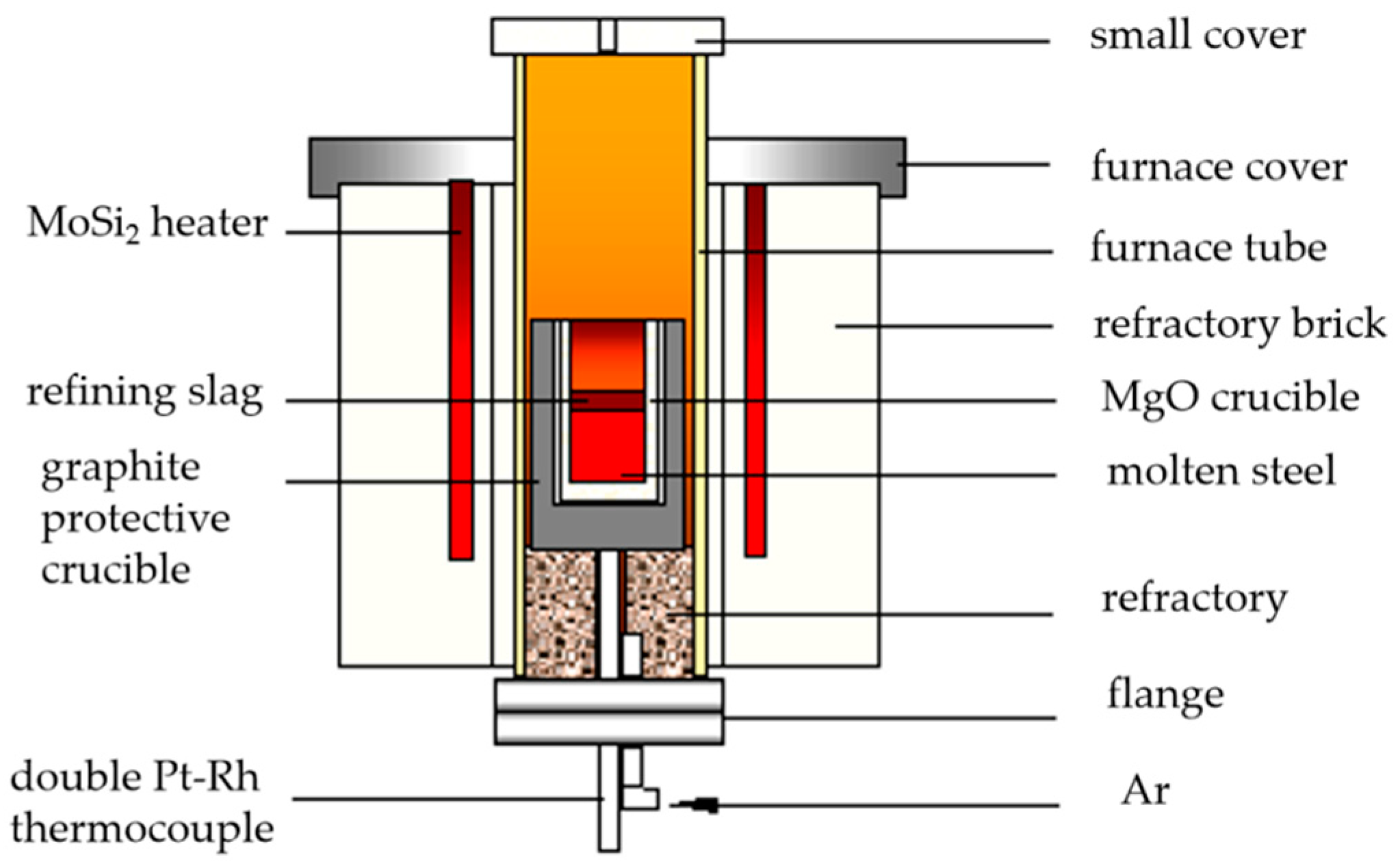
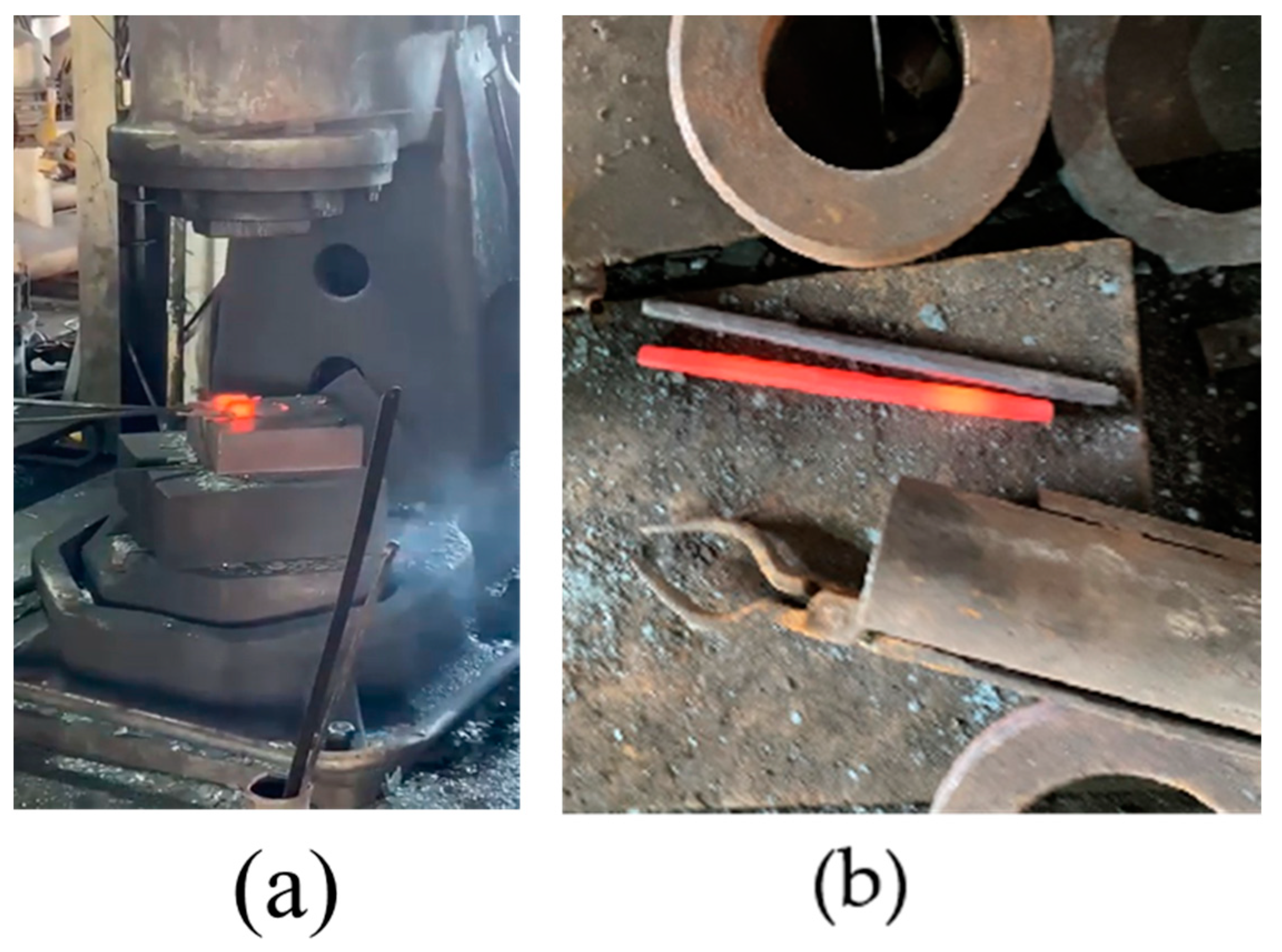










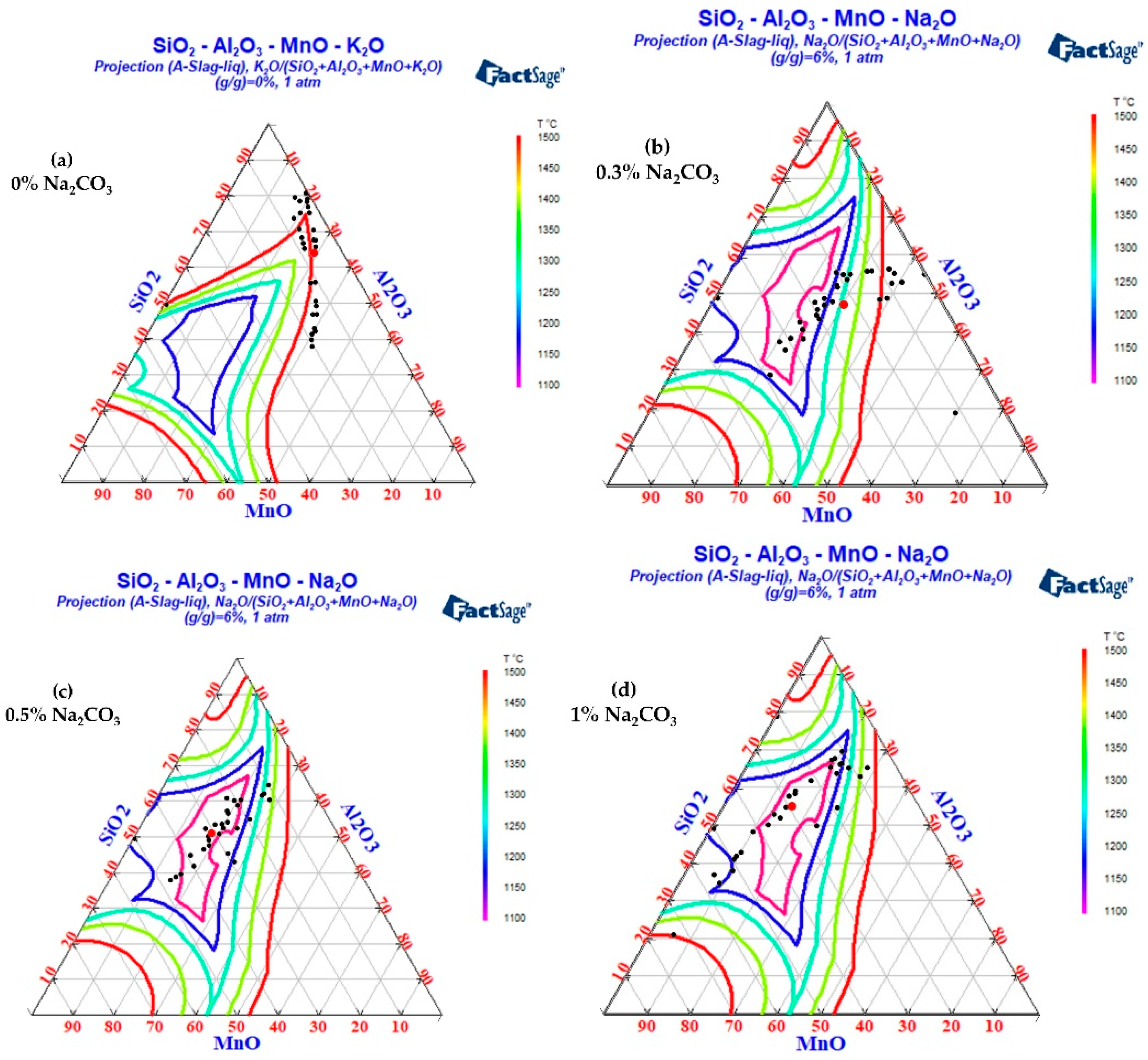

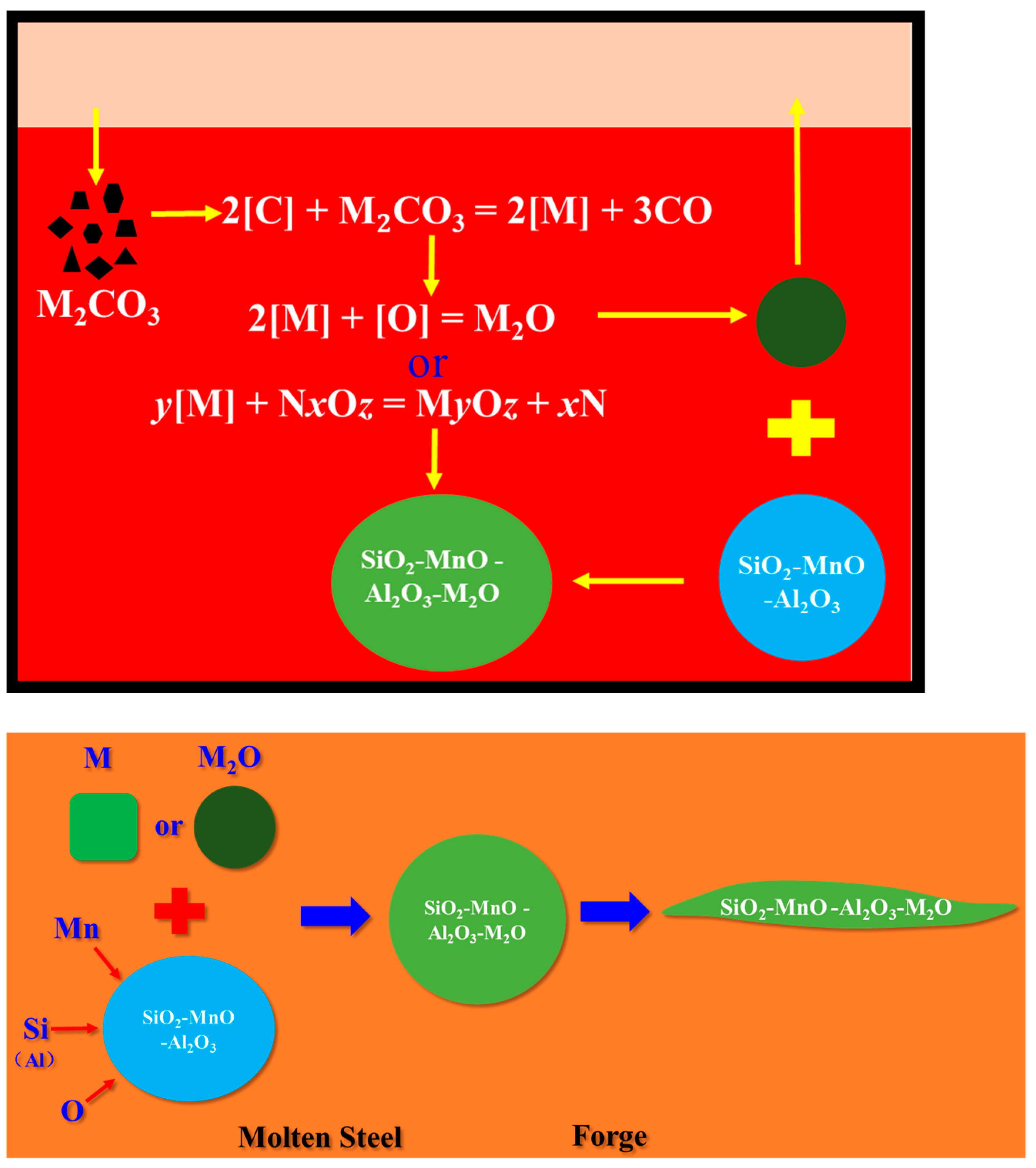
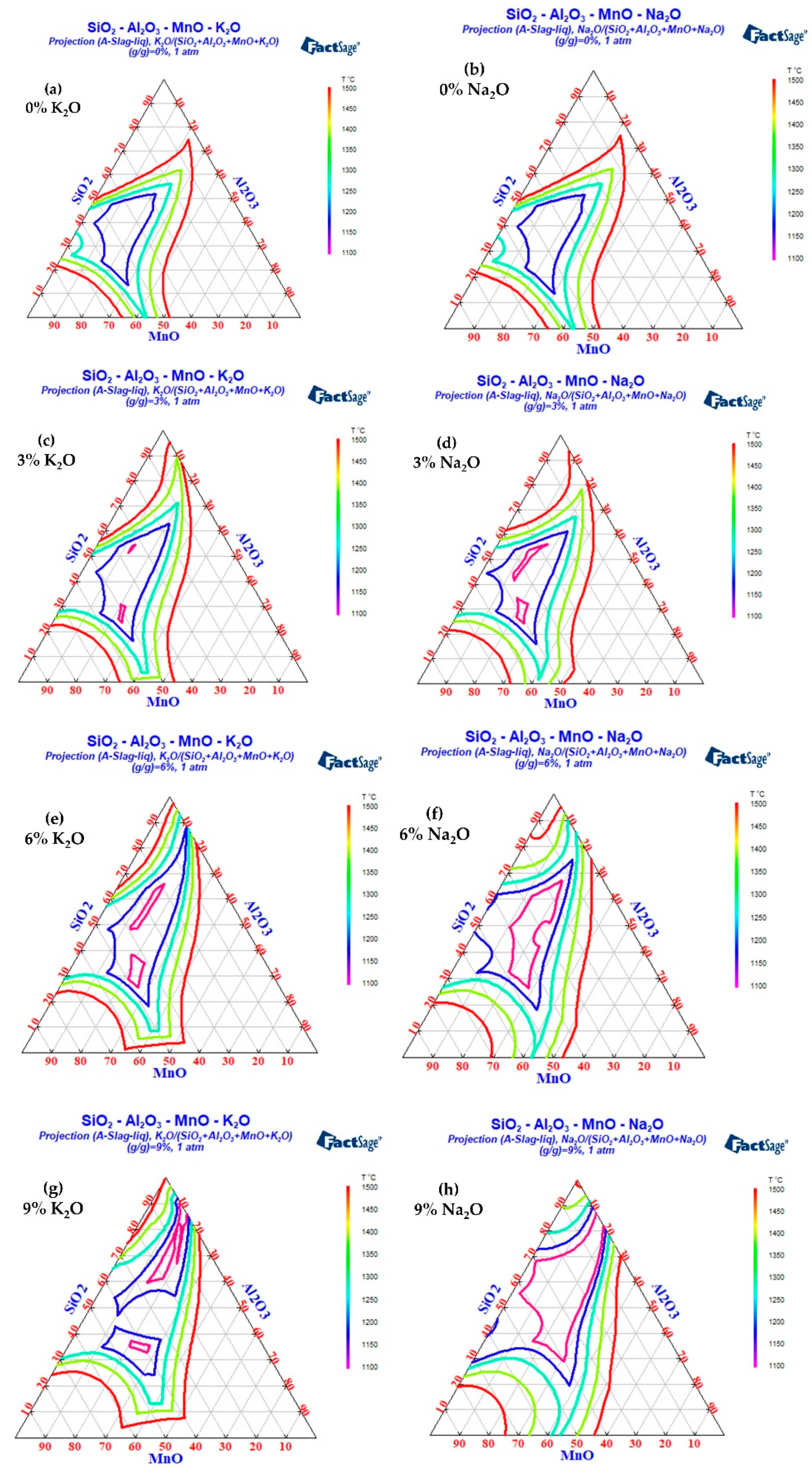
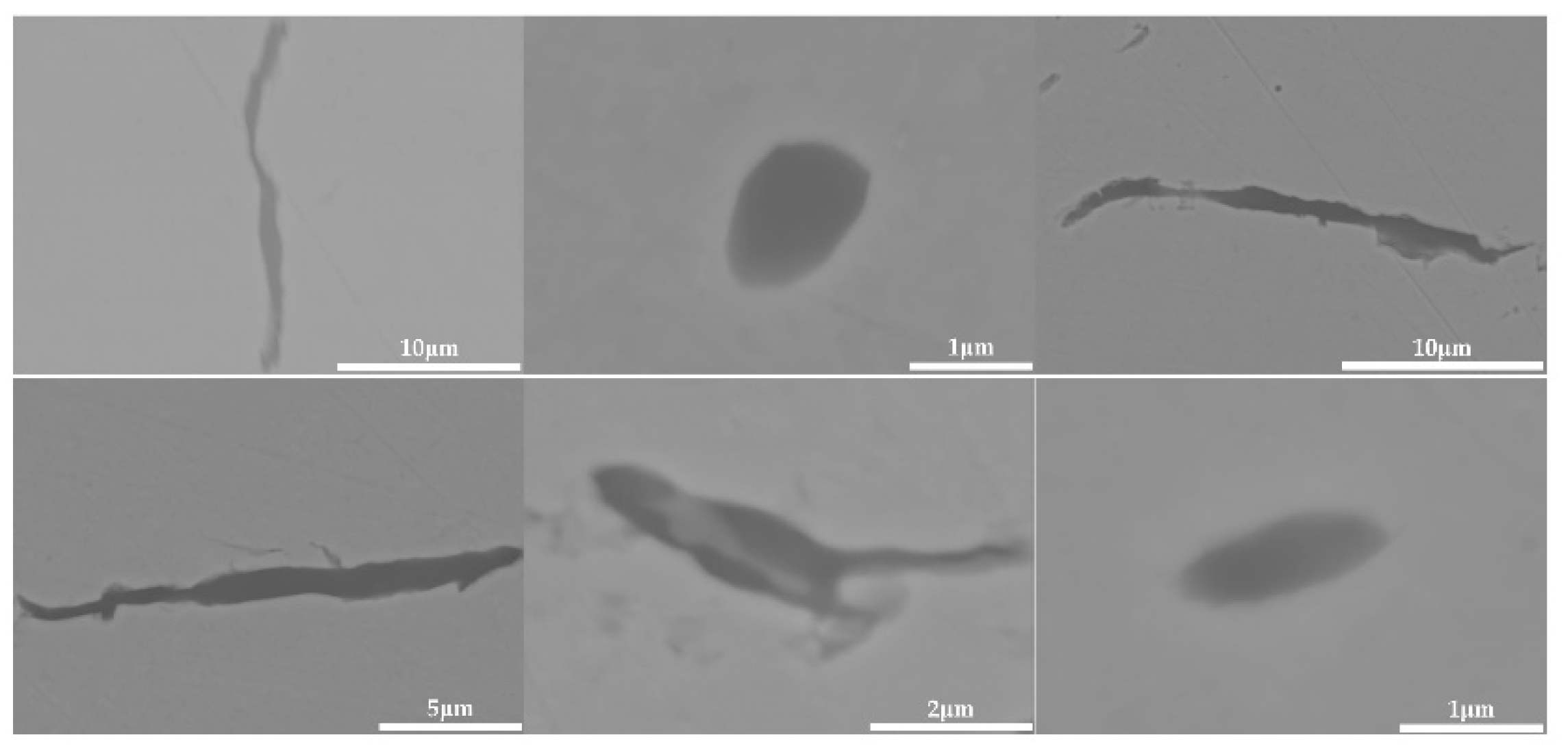

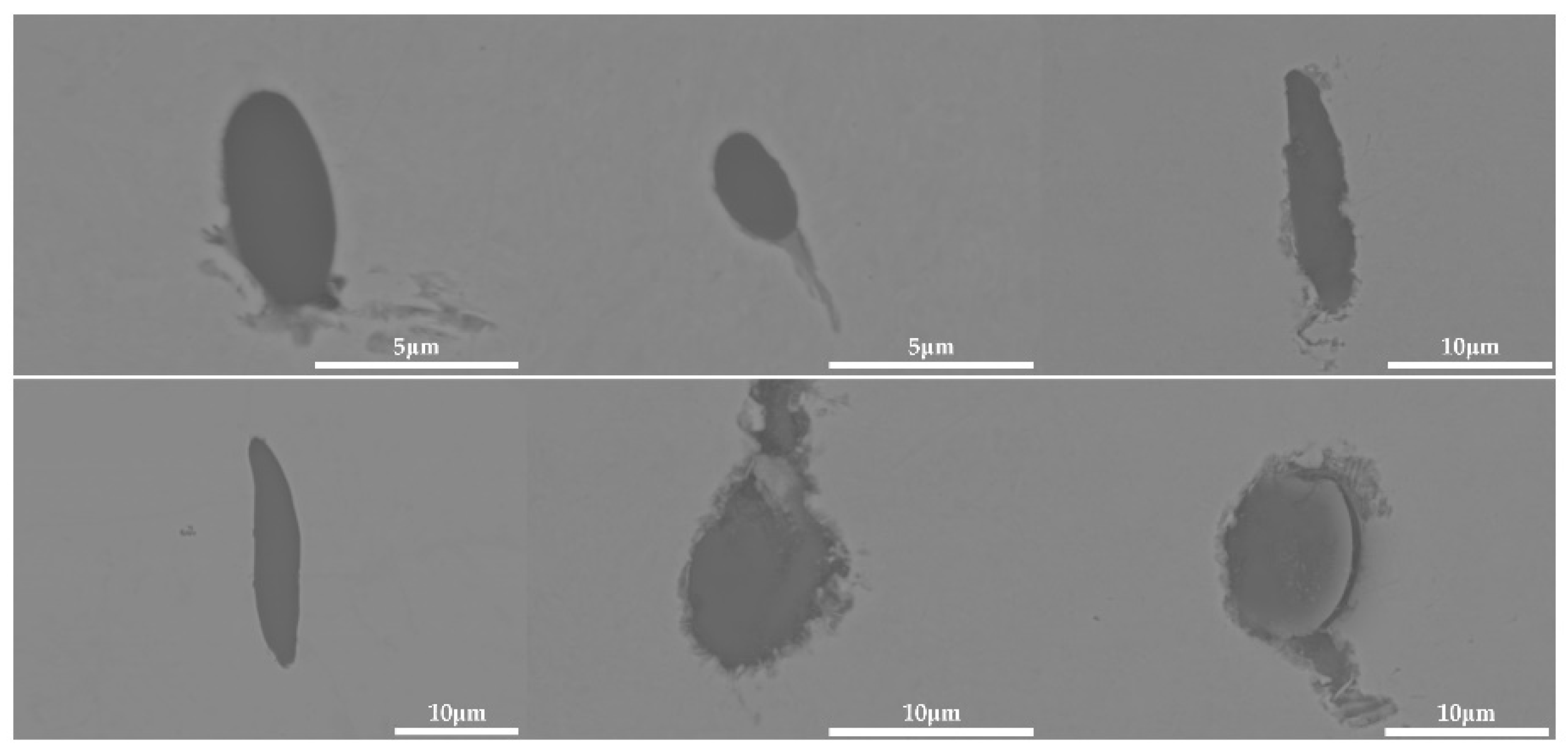
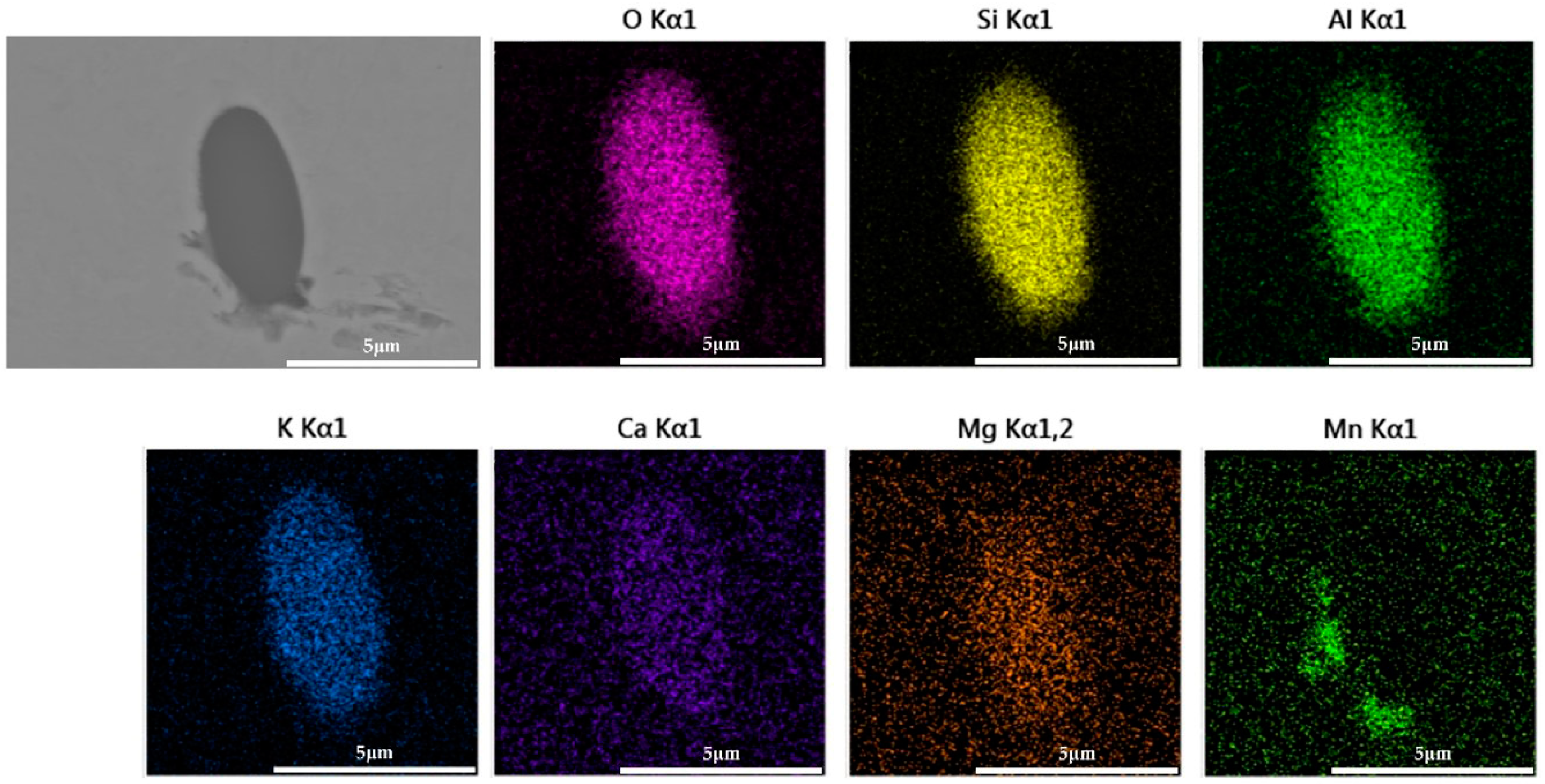
| C | Si | Mn | P | S | Cr | Ni | Cu | Ti | Al |
|---|---|---|---|---|---|---|---|---|---|
| 0.82 | 0.20 | 0.52 | 0.004 | 0.005 | 0.03 | 0.03 | 0.04 | 0.0008 | 0.0015 |
| SiO2 | Al2O3 | CaO | MgO | T.Fe | MnO | R |
|---|---|---|---|---|---|---|
| 41 | 5 | 42 | 6 | 2 | 4 | 1.02 |
| Element | C | Si | Mn | V | Nb | N | P | S |
|---|---|---|---|---|---|---|---|---|
| −0.45 | −0.131 | −0.021 | −0.3 | −0.14 | 0.057 | 0.07 | −0.133 |
Disclaimer/Publisher’s Note: The statements, opinions and data contained in all publications are solely those of the individual author(s) and contributor(s) and not of MDPI and/or the editor(s). MDPI and/or the editor(s) disclaim responsibility for any injury to people or property resulting from any ideas, methods, instructions or products referred to in the content. |
© 2023 by the authors. Licensee MDPI, Basel, Switzerland. This article is an open access article distributed under the terms and conditions of the Creative Commons Attribution (CC BY) license (https://creativecommons.org/licenses/by/4.0/).
Share and Cite
Zhao, J.; Wang, Y.; Wang, M.; Ma, H.; Bao, Y.; Jiang, H.; Hou, D. Effects of Na2O, K2O and B2O3 on Deformability of SiO2-MnO-Al2O3 Inclusion in High-Carbon Steel. Metals 2023, 13, 1341. https://doi.org/10.3390/met13081341
Zhao J, Wang Y, Wang M, Ma H, Bao Y, Jiang H, Hou D. Effects of Na2O, K2O and B2O3 on Deformability of SiO2-MnO-Al2O3 Inclusion in High-Carbon Steel. Metals. 2023; 13(8):1341. https://doi.org/10.3390/met13081341
Chicago/Turabian StyleZhao, Jiaqi, Yanping Wang, Min Wang, Han Ma, Yanping Bao, Haitao Jiang, and Dong Hou. 2023. "Effects of Na2O, K2O and B2O3 on Deformability of SiO2-MnO-Al2O3 Inclusion in High-Carbon Steel" Metals 13, no. 8: 1341. https://doi.org/10.3390/met13081341
APA StyleZhao, J., Wang, Y., Wang, M., Ma, H., Bao, Y., Jiang, H., & Hou, D. (2023). Effects of Na2O, K2O and B2O3 on Deformability of SiO2-MnO-Al2O3 Inclusion in High-Carbon Steel. Metals, 13(8), 1341. https://doi.org/10.3390/met13081341









